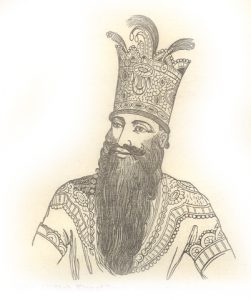 I don’t know about you, but I hate when I get things wrong, especially subjects related to the Bible. It recently came to my attention that I’ve been making a statement that is not accurate. This week I want to set the record straight.
I don’t know about you, but I hate when I get things wrong, especially subjects related to the Bible. It recently came to my attention that I’ve been making a statement that is not accurate. This week I want to set the record straight.
As many of you know, I’ve often claimed that the sum total of Sir Robert Anderson’s evidence for his Artaxerxes Assumption is a quote by Rawlinson regarding Artaxerxes’, Ezra’s, & Nehemiah’s place in the 2nd temple era. Well, it turns out, due to sloppy research on my part, this is not an accurate statement. To give you the context of my erroneous statement here is a quote taken from my book Daniel’s Seventy Weeks: The Keystone of Bible Prophecy:
“By far, the decree by this unnamed Persian Artaxerxes— once again presumed to be Longimanus, known to history as Artaxerxes I— is the most popular choice when scholars look for the commandment to restore and build Jerusalem prophesied by Daniel. Sir Robert Anderson, the great Christian writer, popularized this theory in his influential book The Coming Prince. Anderson does indeed make an impressive case, but surprisingly, he fails to address the scriptural basis for his belief that Ezra and Nehemiah were contemporaries of Longimanus. Instead, Anderson, in one of the most far-reaching eschatological errors of the past two centuries, simply defers to the judgment of the great historian Rawlinson. I quote Rawlinson as found on p. 71 of Anderson’s The Coming Prince:
“Artaxerxes I reigned forty years, from 465 to 425. He is mentioned by Herodotus once (6. 98), by Thucydides frequently. Both writers were his contemporaries. There is every reason to believe that he was the king who sent Ezra and Nehemiah to Jerusalem, and sanctioned the restoration of the fortifications.”— RAWLINSON, Herodotus, vol. 4, p. 217.
Did you catch that? “There is every reason to believe” is the sum of Rawlinson’s and Anderson’s evidence for Ezra and Nehemiah’s place in the Second Temple era! Not a single reference to Ezra’s age or the natural chronological flow of Ezra 6 and 7 is mentioned. Anderson, out of a well-intentioned necessity to prove his interpretation of Daniel 9, simply ignored the biblical evidence, instead relying on unsubstantiated claims by another respected historian.” (Struse, William. Daniel’s 70 Weeks: The Keystone of Bible Prophecy (Prophecies & Patterns Book 2) (Kindle Locations 1539-1554). PalmoniQuest LLC. Kindle Edition. )
The above statement is not entirely correct. Anderson does in fact provide some evidence to support his Artaxerxes Assumption. That evidence is found in Appendix 2 of his book, The Coming Prince. I’ve reproduced the passage in question:
 “So thorough is the unanimity with which the Artaxerxes of Nehemiah is now admitted to be Longimanus, that it is no longer necessary to offer proof of it. Josephus indeed attributes these events to Xerxes, but his history of the reigns of Xerxes and Artaxerxes is so hopelessly in error as to be utterly worthless. In fact he transposes the events of these respective reigns (see, Ant. 11, caps 5: and 7.) Nehemiah’s master reigned not less than thirty-two years (Nehemiah 13: 6); and his reign was subsequent to that of Darius Hystaspes (comp. Ezra 6: 1 and 7: 1), and prior to that of Darius Nothus (Nehemiah 12: 22). He must, therefore, be either Longimanus or Memnon, for no other king after Darius Hystaspes reigned thirty-two years, and it is certain Nehemiah’s mission was not so late as the twentieth of Artaxerxes Mnemon, viz, B.C. 385.
“So thorough is the unanimity with which the Artaxerxes of Nehemiah is now admitted to be Longimanus, that it is no longer necessary to offer proof of it. Josephus indeed attributes these events to Xerxes, but his history of the reigns of Xerxes and Artaxerxes is so hopelessly in error as to be utterly worthless. In fact he transposes the events of these respective reigns (see, Ant. 11, caps 5: and 7.) Nehemiah’s master reigned not less than thirty-two years (Nehemiah 13: 6); and his reign was subsequent to that of Darius Hystaspes (comp. Ezra 6: 1 and 7: 1), and prior to that of Darius Nothus (Nehemiah 12: 22). He must, therefore, be either Longimanus or Memnon, for no other king after Darius Hystaspes reigned thirty-two years, and it is certain Nehemiah’s mission was not so late as the twentieth of Artaxerxes Mnemon, viz, B.C. 385.
This appears, first, from the general tenor of the history; second, because this date is later than that of Malachi, whose prophecy must have been considerably later than the time of Nehemiah; and third, because Eliashib, who was high priest when Nehemiah came to Jerusalem, was grandson of Jeshua, who was high priest in the first year of Cyrus (Nehemiah 3: 1; 12: 10; Ezra 2: 2; 3: 2); and from the first year of Cyrus (B.C. 536), to the twentieth of Artaxerxes Longimanus (B.C. 445), was ninety-one years, leaving room for precisely three generations. [1] [1] Encyc. Brit, 9th ed, title “Artaxerxes.” (Anderson, Sir Robert. The Coming Prince (p. 188). Great Plains Press. Kindle Edition. )”
So as you can see, Sir Robert Anderson does offer some Biblical proof for his Artaxerxes Assumption. It’s only fair to note Anderson’s rather forward opening statement:
“So thorough is the unanimity with which the Artaxerxes of Nehemiah is now admitted to be Longimanus, that it is no longer necessary to offer proof of it.”
I know, it may sound like a bit of sour grapes on my part, but this statement is disappointing to me. Since when is unanimity of consensus valid proof of the accuracy of any truth claim? If you’ve searched the historical record yourself, then you know that in fact nearly every one of those who share this unanimity of consensus about Artaxerxes Longimanus, Ezra, and Nehemiah, instead of reasonable Biblical evidence related to the subject, they only offer the opinions of their peers.
Regarding Anderson’s statement of Josephus’s chronology I must agree. Josephus’s rendering of the Persian chronology is all over the board. His statements are often confusing and sometimes contradictory. He does provide a wealth of historical information, but it takes a great deal of effort to separate the fact from the well-meaning fiction.
So let’s look at the one piece of evidence for Sir Robert Anderson’s Artaxerxes Assumption that can be verified and see how it stands up under the light of the Biblical evidence. For context sake keep in mind here that Anderson’s three points are in rebuttal to Josephus’s claims that Nehemiah (and Ezra) were contemporaries of Xerxes, Josephus being one of the few who do not hold the “unanimity of consensus” Anderson describes above. Anderson’s three points against Josephus’s claims are as follows:
1. “…first, from the general tenor of the history;
2. “…second, because this date is later than that of Malachi, whose prophecy must have been considerably later than the time of Nehemiah;
3. “…and third, because Eliashib, who was high priest when Nehemiah came to Jerusalem, was grandson of Jeshua, who was high priest in the first year of Cyrus (Nehemiah 3: 1; 12: 10; Ezra 2: 2; 3: 2); and from the first year of Cyrus (B.C. 536), to the twentieth of Artaxerxes Longimanus (B.C. 445), was ninety-one years, leaving room for precisely three generations. [1] [1] Encyc. Brit, 9th ed, title “Artaxerxes.”
Of the three points above only the third provides solid Biblical and historical chronology for us to verify. So let’s look at priestly service of Eliashib during the governorship of Nehemiah to see which Persian Artaxerxes most likely qualifies as “Artaxerxes” of Ezra and Nehemiah. But first the Biblical context of Eliashib the high priest:
And Jeshua begat Joiakim, Joiakim also begat Eliashib, and Eliashib begat Joiada, And Joiada begat Jonathan, and Jonathan begat Jaddua. (Nehemiah 12:10-11)
The Levites in the days of Eliashib, Joiada, and Johanan, and Jaddua, were recorded chief of the fathers: also the priests, to the reign of Darius the Persian. (Nehemiah 12:22)
Then Eliashib the high priest rose up with his brethren the priests, and they builded the sheep gate; they sanctified it, and set up the doors of it; even unto the tower of Meah they sanctified it, unto the tower of Hananeel. (Nehemiah 3:1)
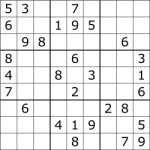
Numbers Provided
To see if Sir Robert Anderson’s claim about Eliashib stand up to reasonable scrutiny, we will look at the evidence in a similar manner as one would solve a Sudoku puzzle. For those not familiar with these number games, a Sudoku puzzle is a cube composed of nine 3×3 sub-grids. The object of the puzzle is to fill all the boxes with single digits where no line or column of numbers repeats itself. Each 3×3 box must contain a digit from 1-9 without any repeated numbers and each line of numbers must be a single digit of 1-9 without any repeated numbers.
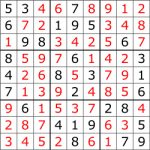
Red Numbers are Unknown
The challenge of a Sudoku puzzle is that each number added to the matrix further influences the arrangement of the other numbers and constrains subsequent additions to the puzzle. Sometimes you can get down to the final answer to the puzzle and find that some of your assumptions have been incorrect even though your placement of the numbers appeared to work initially. Each puzzle starts with a certain number of boxes with a few numbers already provided. Building upon the numbers already provided you then fill in the rest of the boxes with numbers.
Our Biblical Sudoku puzzle is an organization of historical and Biblical facts. These are arranged on a chronological grid and our job is to arrange those facts so that they do not contradict or falsify each other. The events or facts that are either reasonably established or chronologically fixed are in black. All facts that are not chronologically fixed are in red. All of the facts below must be taken into account when organizing the chronology of Eliashib, Ezra, Nehemiah, and Artaxerxes. Here are some of the chronological facts related to Eliashib’s place in the 2nd temple era:
-
-
- The Tabernacle service was performed by men ages 30-50. (Num. 4:1-4) The Levitical service was performed by men ages 25-50. (Num. 8:24) Later the age limit was lowered to 20-50. (I Chron. 23:24)
- The high priest excepted (it appears they served until death – not entirely clear) (Num. 35:25-28; Jos. 20:6)
- The average length of priestly service during Solomon’s temple
- 12 or 13 priest from Zadok to Seraiah
- Average length of 1st Temple service was 29-31 yrs. (Average number of years for each priest from completion of 1st Temple (960-970 BC) to its destruction in 18th year of Nebuchadnezzar 585 BC)
- Seraiah (last high priest of Solomon’s temple) was killed in the 19th year of Nebuchadnezzar (584 BC) (2nd Chron. 25:8-21)
- Jehozadak (son of Seraiah) was taken captive by Nebuchadnezzar “when YHWH carried away Judah and Jerusalem by the hand of Nebuchadnezzar” (I Chron. 6:15)
- 1st captivity of Judah: Daniel taken captive (604 BC) (Dan 1:1)
- 2nd captivity of Judah 8th yr. Nebuchadnezzar carried away “all Jerusalem” (595 BC) ( 2nd Kings 24, 2 Chr. 36)
- 3rd captivity of Judah – 19th yr. of Nebuchadnezzar – Jerusalem destroyed, all except the poor taken captive (584 BC) (Jer. 52:28-31, 2nd Kings 24-25, 2 Chr. 36)
- 4th captivity of Judah – 23rd yr. Nebuchadnezzar (580 BC) (Jer. 52:28-31)
- Nehemiah’s “Artaxerxes” reigned at least 32 years (Neh. 13:6)
- Darius ‘the great’ Artaxerxes reigned 36 years (521-486 BC)
- Artaxerxes I (Longimanus) reigned 41 years (464-424 BC)
- Ezra (the priest and scribe) went up to Jerusalem in the 7th year of “Artaxerxes” (Ezra 7)
- Ezra & Nehemiah taught the people the Torah in the 20th year of “Artaxerxes” (Neh. 8:8-9)
- Nehemiah served as governor of Jerusalem from the 20th – 32nd yr. of an “Artaxerxes” (Neh. 5:14)
- Nehemiah and the people rebuilt the wall in Jerusalem in the 20th yr. of “Artaxerxes” (Ezra 7-8
- 1st year of Cyrus (536 BC)
-
- Yeshua (Joshua – high priest) went up to Jerusalem (Ezra 1-3)
- Zerubbabel the governor went up to Jerusalem (Ezra 1-3)
- Priest, Levites, and temple porters went up to Jerusalem (Neh. 12)
-
- Ezra and Nehemiah were contemporaries (Neh. 8:9; 12:26)
- Many of the Priests, Levites, and temple porters of Neh. 12 (536 BC) were still alive in the 20th year of a Persian “Artaxerxes” (Neh. 10-11)
- 2nd year of Darius ‘the great’ Artaxerxes (520 BC)
-
- Construction on the temple was restarted (Ezra 4:24; Hag. 1; Zech 1)
-
- 6th year of Darius ‘the great’ Artaxerxes (516 BC)
- Construction on the temple was completed (Ezra 6:13-15)
- Joiakim (son of Joshua the high priest) was a contemporary of Nehemiah & Ezra (Neh. 12:26)
- Eliashib, Joiada, Johanan, & Jaddua were priest up to or during the reign of “Darius the Persian”. (Neh. 12:22)
- Eliashib the high priest rose up with his brethren and built the wall of Jerusalem in the 20th year of an “Artaxerxes”.1
- By the 32nd year of “Artaxerxes” Nehemiah had learned of the evil done by Eliashib for Tobiah (Neh. 13:7)
- By the 32nd year of “Artaxerxes” one of Joiada’s sons (Eliashib the high priest’s grandson) was son in law to Sanballat the Horonite. (Neh. 13:28)
- The Tabernacle service was performed by men ages 30-50. (Num. 4:1-4) The Levitical service was performed by men ages 25-50. (Num. 8:24) Later the age limit was lowered to 20-50. (I Chron. 23:24)

-
Think of the reasonable established chronological facts above (in black) as the numbers already provided for our Biblical Sudoku puzzle. Of these the following are especially important to determining Eliashib’s place in these events:
Seraiah the last high priest of Solomon’s temple was killed in the 19th year of Nebuchadnezzar (roughly 584 BC). He had at least two sons: Jehozadak and Ezra (priest and scribe). Jeohzadak was taken captive by Nebuchadnezzar when “YHWH carried away Judah and Jerusalem by the hand of Nebuchadnezzar”. This was likely the 2nd captivity period of Judah in 595 BC or at the latest the destruction of Jerusalem in 584-585 BC. Ezra was still alive by the 20th year of a Persian “Artaxerxes”. Only two Persian kings reasonable qualify as potential “Artaxerxes” with reigns of 32 years or more as required by Nehemiah 5:14:
-
- Darius (son of Hystaspes) also known as ‘the great’ Artaxerxes. This “Artaxerxes” reigned from 521-486 BC.
- “Artaxerxes” Longimanus (known historically as Artaxerxes I). This “Artaxerxes” reigned from 464-424 BC.
It was in the 20th year of one of these two Persian “Artaxerxes” that Eliashib the high priest rose up and built the wall of Jerusalem. In other words Eliashib was an active participant in the events during the 20th year of a Persian “Artaxerxes”.
Then Eliashib the high priest rose up with his brethren the priests, and they builded the sheep gate; they sanctified it, and set up the doors of it; even unto the tower of Meah they sanctified it, unto the tower of Hananeel. (Nehemiah 3:1)
In the chart below I’ve added nearly all of the chronological information above. For the priestly service I’ve provided three generational date spans for each descendant of Seraiah, the high priest. These dates are based upon a 20, 25, & 30 year generation and they allow us to see a reasonable approximation of the age of high priests during the reigns of Darius & Longimanus.
Keep in mind that all of the chronological facts listed above must reasonably fit within the chronological timeline of events described in the Bible. As each piece of the Biblical Sudoku puzzle is added to the matrix, it further constrains the other events of the remaining chronology. In other words, move one chronological event and it influences the others. The result is that the chronological window for each event gets smaller and smaller and a reasonable picture of the events begins to emerge.
(Click on JPEG Image (below) to Enlarge or download the high resolution PDF here: Artaxerxes & Eliashib)
Summary Concerning Eliashib and “Artaxerxes” Longimanus (circa 464-424 BC)
As you can see from the provided chart, by the 20th year of “Artaxerxes” Longimanus, Eliashib the high priest was between 83-123 years of age. It is unlikely that he was an active participant in rebuilding the wall of Jerusalem. Ezra (the priest and scribe) who read the law to those assembled at the feast of Tabernacles during the 20th year of “Artaxerxes” was (at his youngest) 140 years old and it is also unlikely that he was still alive or active at this time. Nehemiah 12:22 tells us that Eliashib, Joiada, Johanan, and Jaddua were priests until/in the reign of “Darius the Persian”. Only Darius ‘the great’ (Darius I a.k.a “Artaxerxes) or Darius II (Nothus) could qualify as this “Darius the Persian” mentioned in this passage. As can be seen in the chart, it is unlikely that Darius II (Nothus) qualifies as the “Darius the Persian” of Nehemiah 12:22.
- The Levites in the days of Eliashib, Joiada, and Johanan, and Jaddua, were recorded chief of the fathers: also the priests, to the reign of Darius the Persian. (Nehemiah 12:22)
Summary Concerning Eliashib and Darius – ‘the Great’ “Artaxerxes”
As you can see from my chart by the 20th year of Darius ‘the great’ “Artaxerxes”, Eliashib the high priest was between 26-66 years of age. He would have been in the prime of life and capable of building the wall of Jerusalem. Ezra (the priest and scribe) who read the law to those assembled at the feast of Tabernacles was (at his youngest) 83 years old and also capable of performing the activities attributed to him (reading the law to the people), although he was very ancient by this time. Nehemiah 12:22 tells us that Eliashib, Joiada, Johanan, and Jaddua were priests until/in the reign of “Darius the Persian”. The chart above shows that these priests were likely alive during the reign Darius ‘the great’ “Artaxerxes”. Note also that like the priestly service from Zadok to Seraiah (a 30 year generation) most reasonably fits the chronological evidence related to the priestly service from Seraiah to Jaddua.
General Summary:
All the chronological evidence provided above fits reasonably within the reign of Darius ‘the Great’ “Artaxerxes”. There is no reasonable way to account for all of these events during the reign of “Artaxerxes” Longimanus. Contrary to Sir Robert Anderson’s claims, Eliashib’s service does not support his Artaxerxes Assumption regarding Artaxerxes I – Longimanus and his contemporaneous relationship with Ezra and Nehemiah. In fact, a careful reckoning of the facts provides reasonable evidence to show that Eliashib, Ezra, and Nehemiah had a contemporaneous relationship with Darius ‘the Great’ Artaxerxes, but by the reign of “Artaxerxes” Longimanus it is extremely unlikely, even impossible that these characters were still alive, let alone active in the affairs described in the Bible.
In closing, I think it important to remember that no matter how certain someone tells you they are of the Biblical facts, stewardship demands that each and every one of us open our Bibles and “see if these things be so”. In light of our exploration of the facts above I leave you with Sir Robert Anderson’s words as a sobering reminder of our duty as Bereans:
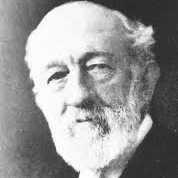
“So thorough is the unanimity with which the Artaxerxes of Nehemiah is now admitted to be Longimanus, that it is no longer necessary to offer proof of it.” (Sir Robert Anderson – The Coiming Prince, Appendix 2)

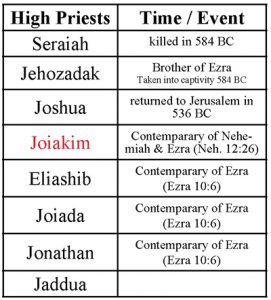




Wow! Impressive numbers review that I so appreciate. Thank you for your transparency, and especially for the labor to research and share openly with your readers. We are (I am) blessed! Galen
Thank you for your encouraging words Galen.
Warm regards,
William
Thanks William, your efforts are much appreciated. It is great to be able to share in your Biblical truth find.
Thank you for the kind words Ron.
Warm regards,
WS
“In closing, I think it important to remember that no matter how certain someone tells you they are of the Biblical facts, stewardship demands that each and every one of us open our Bibles and “see if these things be so”. In light of our exploration of the facts above I leave you with Sir Robert Anderson’s words as a sobering reminder of our duty as Bereans:”
Agree with Stuse against Anderson apparently on Darius I.
Thursday/Friday lectionary Jeremiah 52. Haven’t found agreement on start of 70 Year Exile posited in work by Faulstich. Not sure how he arrived at dates, whether independently or through previous references.
Have not found anybody to agree with him till today. I googled “Zedikiah’s 9th year 10 month 10th day start 70 year exile?” to find https://books.google.com/books?id=z0ytVvRfXVgC&pg=PT165&lpg=PT165&dq=Zedikiah%27s+9th+year+10+month+10th+day++start+70+year+exile?&source=bl&ots=b0HCQIZwZ6&sig=ACfU3U2fd-clwMWSvDuPoeAgn9cH4GYubQ&hl=en&sa=X&ved=2ahUKEwi3itL4nYjlAhXSVN8KHWYaBrEQ6AEwAHoECAkQAQ#v=onepage&q=Zedikiah's%209th%20year%2010%20month%2010th%20day%20%20start%2070%20year%20exile%3F&f=false Anderson seems to agree with Faulstich on start & finish 70 years.
Gene has 590 rather than 589 for terminus a quo
Hi – in my studies and developing a timeline of my own I found that the 3rd year of Jehoiakim is not 606 BC as he was still vassal to Necho II until his 8th year. The third year of Jehoiakim is Jehoiakim’s third year as vassal to Babylon being the same as his 11th year in 598 BC. This is the view Josephus gives in Ant 10.6.1 from memory. A second siege took place 3 months later for Jehoaichin. Both these sieges were stopped short as both kings gave themselves up. 11 years later in 587 BC in Zedekiah’s last year the 3rd siege was complete.
The incorrect view of Jehoiakim’s third year in Daniel 1:1 as being his actual third year as King in 606 BC means there were captives taken whilst Nebuchadnezzar was occupied at Carchemish which did not conclude until the following year in 605 BC being the same as Jehoiakim’s 4th year also. That 4th year the prophecy of the 70 years was given to Jeremiah. See the problem?
Making Daniel 1:1 3rd year to be 606 BC means the first captivity occurred 1 year before the 70 year prophecy was given.
Other ramifications of this false view which has pervaded the minds of many is that they fail to realize that no king was taken in 606 BC. Why? Because there was no siege that year and wouldn’t be until the first in 598 BC. Note one does not lay siege to a city, take captives and not take its king. Why hasn’t anyone picked up on this? Lastly the incorrect view of 606 BC being the 3rd year assumes Nebuchadnezzar had to deal with the captives (but no king) during the battle of Carchemish which scholars then assume he sent them onto Babylon that year which is of course false.
A plain reading of Scripture and placing all the elements into a timeline shows that Nebuchadnezzar finished up at Carchemish in 605 BC in Jehoiakim’s 4th year, Necho II retreated to Egypt, and Nebuchadnezzar arrived at Jerusalem by the end of Jehoiakim’s 8th year to force Jehoiakim as vassal starting in his 9th year which lasted for 3 years ending in his 11th year the same being as Nebuchadnezzar’s 19th year in 598 BC. The new forced allegiance to Babylon annulled the 8 year Egyptian vassalage. So from 605/604 BC to last year of vassal to Egypt was 601 BC – 4 years – this means it took Nebuchadnezzar 4 years to move south to Jerusalem – a fact I later confirmed reading Josephus.
Thus Daniel 1:1, 2 Kings 24:12 and 2 Chronicles 36:6 are all the same event. Hope this helps.
Hi Alex,
Thanks for your comments. Always appreciate looking at the subject from another perspective. Its been a while since I studied this. I’ll take a look when I have time.
Warm regards,
William
Just looking at your graph now you have 2 year co reign of Nebuchadnezzar for years 604 and 603 BC. How can this be so when Nebuchadnezzar’s father Nabopolassar died in 605 BC as the battle of Carchemish was finishing up and 605 BC was Nebuchadnezzar’s ascension year and his first year as sole King of Babylon being 604 BC? Also his 19th year was 587/586 BC not 584 BC same as Zedekiah’s 11th being the year the city of Jerusalem was breached and a month later the city and First Temple destroyed.
So your Daniel 1:1 3rd year is 604 BC (others 606 BC as related in previous post) – this difference on your chart appears to be a function of the misapplication above of the 2 year co reign. This also affects your timeline to have Zedekiah’s 11th year as 584 BC. This 2 year co-reign ought to be omitted and Daniel 1:1 be instated or reappraised as per previous post to not 606 or 604 BC but Jehoiakim’s 11th year (3rd as vassal to Babylon) in 598 BC.
That said I agree with your year for Cyrus II first year as 536 BC but curiously you have no 2 year reign for Darius the Mede aka Cyaxares II (Median uncle to Cyrus II – Cyrus II was paternally Persian as he married Cyaxares II older sister Mandane) as per the reliable account of Xenophon. The account of Herodotus is not Scripturally tenable due to Persian dominance of Media prior to the Fall of Babylon – yet refer Isaiah 13:17, Jeremiah 51:11 and 51:18 which states the opposite. Herodotus has Cyrus II deposing his grandfather Astyages 10 years before the Fall of Babylon which if true makes Persia the dominant power in 539 BC. This was not the case.
At the Fall of Babylon in 539 BC it was Darius the Mede aka Cyaxares II King of Media who was the dominant King and his nephew King Cyrus II of Persia led the combined forces of the Medo-Persian army against Babylon under Darius the Mede. Cyrus II had become King of Persia since his father Cambyses I died in 559 BC. So 539 BC was Cyrus’ 21st year as King of Persia.
Darius died in 537 BC 2 years after the Fall of Babylon which is why I agree with your 1st year of Cyrus II as King of Persia, Media and Babylon in 536 BC. The death of his uncle Cyaxares II meant that Cyrus II received the realm of Media (and Babylon) by legitimate succession (Xenophon) and not by bloodshed with his mothers house and by deposing his grandfather Astyages (Herodotus). You have not placed said Fall of Babylon in 539 BC on your chart that I can see – this would be recommended. Keep up the good work. Always room for improvement.
Thanks again Alex. Appreciate your cordial comments.